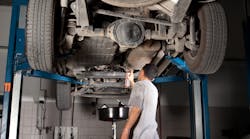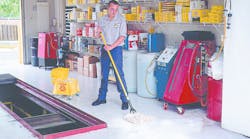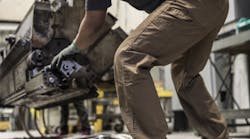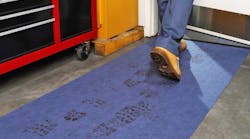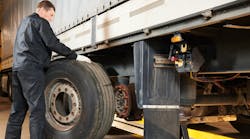No one wants a workplace that isn't safe for their employees. No doubt you are already taking sensible measures to control hazards and risks. But, are you doing enough about trip, slip and fall accidents?
Slips, trips and falls can happen in any workplace and may result in such injuries as sprains or strains, bruises, broken bones, back injuries, contusions, abrasions and lacerations. Frequently, the result is a disabling injury that impacts an employee’s ability to do his or her job, resulting in lost workdays and reduced productivity.
Additionally, these accidents could mean a loss of productivity and business, increased insurance premiums and added costs associated with training replacement workers.
DEFINITIONS
Slips – Slips usually occur when there is too little friction or traction between the footwear and the walking or working surface, resulting in loss of balance.
Floor surfaces require sufficient grip to prevent slipping, especially in areas which may become wet or contaminated. The greater the thickness or viscosity of the contaminants, the greater the slip resistance of the flooring required to protect against slipping.
Walking surfaces that do not have the same degree of traction is a common cause for slips, according to officials with SAIF (www.saif.com), Oregon's not-for-profit, state-chartered workers' compensation insurance company.
These type of walking surfaces occur when the floor wears unevenly or transitions from one surface to another, SAIF notes. For example, from carpet to a floor with lower friction, such as polished marble or vinyl, or grid to smooth concrete.
Floor contamination – which be anything that ends up on a floor – contribute to slips and falls, add the officials. Wet sources of contamination include water, oils, grease and soap from cleaning solutions. Dry contamination includes dusts, powders, granules, metal shavings; plastic bags and other small objects like metal nuts and bolts spilled on the floor.
Other causes of slips:
- Sloped walking surfaces.
- Loose and/or unsecured rugs or mats.
- Wet, muddy or greasy shoes.
- Sloped, uneven or muddy terrain.
- Ramps and gang planks without skid- or slip-resistant surfaces
- Freshly-waxed surfaces.
- Mounting and dismounting vehicles and equipment.
- Climbing ladders.
- Loose, irregular surfaces, such as gravel.
Trips – Trips occur when an individual’s foot or lower leg contacts a low object in their path – which is not easily visible or noticed, and the upper body momentum continues, resulting in loss of balance. Trips happen when stepping down to a lower surface and losing balance or due to uneven floors or working surfaces.
As little as a 1/4" rise in a walkway can cause a person to stub their toe, resulting in a trip and fall, SAIF officials point out. The same thing can happen going up a flight of stairs. With only a slight difference in the height of subsequent steps, a person can trip and fall.
Additional common causes for trips include:
- Cords, hoses, cables, wires and debris in aisles, walkways and work areas.
- Clutter and obstacles in aisles, walkways and work areas.
- An obstructed view.
- Changes in elevation or levels.
- Uneven, non-uniform, improper, irregular or damaged steps.
- Rumpled carpets and mats or carpets/mats with curled edges.
- Irregularities in walking surfaces.
Falls – Falls occur when a person becomes too far off center of balance. Officials with the Occupational Safety and Health Administration (OSHA) note that there are two main types of falls:
- Fall at same level. A fall to the same walking or working surface, or a fall into or against objects above the same surface
- Fall to a lower level. A fall to a level below walking or working surface.
A fall occur, add SAIF officials, when a person unexpectedly steps down to a lower surface. For example, when an individual thinks they're on the last step of a set of stairs, but has one more step to go before reaching the landing. Or, if a person unexpectedly steps off of a curb.
COSTLY
Two of the most common causes for slips and falls are slippery or uneven walking surfaces, say officials with Zurich Insurance Group (www.zurich.com), a multi-line insurer that serves its customers in global and local markets.
Slips, trips and falls account for one of the greatest workers’ compensation and general liability exposures, the insurance group points out.
The National Safety Council (www.nsc.org) estimates more than 25,000 slip, fall and trip accidents occur every day in the U.S. These accidents are the second leading cause of unintentional workplace fatalities, according to the council.
The average disabling claims cost of a slip, trip and fall is $22,000, according to SAIF.
PREVENTION
Yet, say safety officials, these types of accidents, and their resulting injuries, are easily preventable. This can be done, OSHA (www.osha.gov) officials say, by, among other things:
- Designing workplaces and processes to prevent potential exposures to slip, trip and fall hazards.
- Good housekeeping to maintain clear, tidy work areas free of clutter.
- Following safe walking practices and routes.
- Wearing proper footwear with good traction.
- Learning to fall “properly” – using techniques that can minimize fall injuries.
Zurich officials say “it is important to take the time to evaluate every area of your facility and find where these risks could arise, specifically in high-traffic areas.”
The company has developed its Slip, trip and fall evaluation form to help evaluate and analyze what it has identified as the 10 main contributing factors for these types of accidents. Those factors are:
- Surface composition.
- Foreign substance potential.
- Surface conditions.
- Surface changes.
- Level changes.
- Obstructions.
- Visibility.
- Human factors.
- Stairs (includes any elevators and escalators).
- Unusual features.
The Slip, trip and fall evaluation form and the Contributing Factor Guide are included within this article.
Zurich officials say the evaluation can be used to establish an action plan to reduce slips, trips and falls.
“Not only will you need to make changes to areas with potential for risks, but you will also need to put administrative policies in place to make sure everyone knows the proper procedures,” they advise.
CONTROL
The final step in the assessment program is to determine how to control any slip, trip and fall risks that have been identified, say the Zurich officials. A method for this is to create a slip, trip and fall action plan worksheet to use for each issue that has been identified a high risk through the Slip, trip and fall evaluation form.
This worksheet should include:
- The slip, trip and fall prevention item number.
- A description of the physical changes need to improve the condition.
- A description of the administrative changes needed to improve the condition.
- The managers/team members responsible for corrective actions.
- A target date for completion of the corrective actions.
- Any other miscellaneous comments or information.
The officials point out that each slip, trip and fall issue “is unique and requires careful consideration of what level of control is desirable, what resources are available and what is technically feasible. Because of these differences, action plans to control each different exposure in a particular area of your facility will also be unique.
“You will probably find that in most cases more than one change is needed to affect a long-term solution to the problem.
They offer these suggestions for possible controls to get started:
Physical changes
- Repair deficiencies in floor surfaces and railings.
- Replace slick floor material with surfaces having a higher coefficient of friction.
- Install grab bars and rails where appropriate.
- Avoid furnishings that might slip when leaned upon.
- Apply slip-resistant coatings in showers, baths and bathroom floors.
- Use color contrasts to make steps or other level changes more visible.
- Make sure all floor surfaces are adequately lit at night.
Administrative changes
- Ensure that supervisors and staff are aware of their responsibilities for fall prevention.
- Schedule and monitor preventive maintenance on rolling equipment.
- Cover fall prevention topics often during employee training.
- Include fall prevention items on routine self-inspection forms.
- Ensure corrective action follow-up by management.
